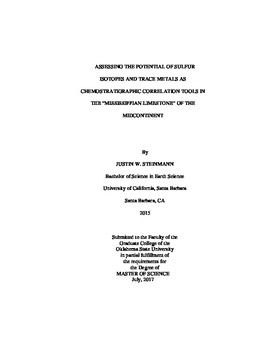| dc.contributor.advisor | Riedinger, Natascha | |
| dc.contributor.author | Steinmann, Justin W. | |
| dc.date.accessioned | 2018-06-25T16:31:28Z | |
| dc.date.available | 2018-06-25T16:31:28Z | |
| dc.date.issued | 2017-07-01 | |
| dc.identifier.uri | https://hdl.handle.net/11244/300318 | |
| dc.description.abstract | The “Mississippian Limestone” in the Midcontinent, United States, has proven to be a prolific hydrocarbon reservoir and has been intensely studied with regard to lithology, sequence stratigraphy, and facies distribution. Discontinuous lithology and heterogeneous facies of complex carbonate systems, however, make conventional correlation methods, such as lithostratigraphy, difficult. Two novel chemostratigraphic tools may provide a solution to this correlation-challenge: the sulfur isotope composition of carbonate associated sulfate (CAS), which is used as a proxy for the isotope composition of seawater sulfate at the time of carbonate formation and has been successfully applied to reconstruct changes in biogeochemical sulfur cycling on a global scale, and trace metals (TMs), which have been successfully applied in shales as proxies for paleoseawater redox conditions. Utilizing a framework of sequence stratigraphy for the Mississippian limestone in southwest Missouri, we tested the application of CAS isotopes and TM content as correlation tools on samples taken along vertical and horizontal transects from the St. Joe Group. The sulfur concentration and isotope composition of CAS were determined using a leaching and dissolution procedure. The TM content was determined for the carbonate fraction as well as the bulk rock fraction including the siliciclastic phases; samples were analyzed by inductively coupled plasma mass spectrometry. CAS results show a good correlation of the sulfur isotope signal along a lateral transect over hundreds of meters and reflect temporal variations on time scales similar to 3rd-order sequence cycles. The sulfur isotope composition also indicates that the basin was open to global seawater circulation during deposition. Although potential for high-resolution characterization is limited in open ocean basins, CAS isotopes may prove more effective when used for correlation in restricted basin settings. The TM results suggest fluctuating Cd, P, and Ti content on 3rd-order and higher time-scales. The lack of V, U, and Mo enrichments indicate that the rocks were deposited in an oxic environment. Although the effectiveness of CAS and TMs as correlation tools may be limited by the sampling resolution in our study, both parameters can be used to reconstruct the oceanographic conditions of the basin during deposition and thus provide useful information. | |
| dc.format | application/pdf | |
| dc.language | en_US | |
| dc.rights | Copyright is held by the author who has granted the Oklahoma State University Library the non-exclusive right to share this material in its institutional repository. Contact Digital Library Services at lib-dls@okstate.edu or 405-744-9161 for the permission policy on the use, reproduction or distribution of this material. | |
| dc.title | Assessing the Potential of Sulfur Isotopes and Trace Metals as Chemostratigraphic Correlation Tools in the “Mississippian Limestone” of the Midcontinent | |
| dc.contributor.committeeMember | Grammer, G. Michael | |
| dc.contributor.committeeMember | Puckette, James | |
| dc.contributor.committeeMember | Brunner, Ben | |
| osu.filename | Steinmann_okstate_0664M_15319.pdf | |
| osu.accesstype | Open Access | |
| dc.description.department | Geology | |
| dc.type.genre | Thesis | |
| dc.type.material | text | |
